In the beginning there was the herd. The herd traveled as one; each member had its own thoughts but they thought as one being when deciding where to move, when to move, where to eat, to drink, what to do if a predator approached. Their days flowed together and were designed around the quest for food, shelter and space. They shared a language that consisted of body language, sounds, just thinking a desire.
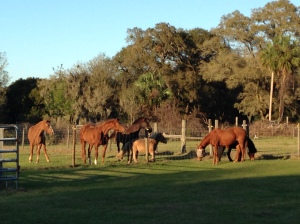
The herd would know when danger was coming, when the weather was changing, by the change in and smells borne on the air, sounds that they only could hear. Their ears swivel and can hear sounds from all around. They felt vibrations of weather, water, other animals, through the earth. The physical contact with one another, the language that passed between them through their bodies and their thoughts, moved them safely as a unit. When a predator was near, a lead horse would round everyone up and say, it’s time to go, head this way. And they would all flow like fish in a stream, together.
The babies learned when they could eat and when they could not from their dams. They learned this as the beginning of manners that would keep them in good stead with the herd, basic etiquette of the horse. They learned basic boundaries and how to remain safe and nourish safety for the herd. They would eventually move up in their status in the herd, yet some would be born with a certain presence that might make them higher in the hierarchy than others of the same age.
As people came to take horses away from the wild, and put them in smaller herds, the horses continued to have their incredible sense of the world, though for some the sensory awareness may change a small amount. Those who are born wild still maintain a highly attuned sensory awareness, untainted by the introduction of scented products, processed foods and medicines.
Horses have remained essentially the same beings from that very beginning. This is what drives them – food, shelter and space.
So I invite you to think about the horse and where she lives today: perhaps in a barn, in a corral separate from other horses, but with the ability to visit over the
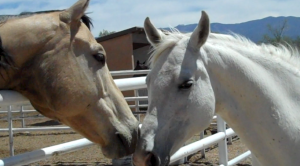
fence. She may have the opportunity to move with other horses in a turnout setting, to groom another horse, regularly or not often. She may not have the ability to exercise the foundations of her innate learning on a daily basis.
This ability to exercise primary foundations of horse herd behavior are what we can put back in a horse’s life. You may say, oh, well, my horse is civilized now. She goes to shows, she wears a blanket or sheet, she eats extruded feed, wears shoes, etc. But the horse underneath these human additions to her life, is the same very wild and natural being. It’s amazing she wants to be in relationship with us and will tolerate wearing all that stuff and eating those things when they are not her natural first choice. She will, in a “civilized” setting, wear what you put on her and eat what you put in front of her. She wants a relationship with you. She knows you are capable of it.
This is where we have a huge responsibility to provide that bridge because we have the intellect to figure out what it is horses want from us. And it’s very simple – these simple Liberty Foundations that horses are missing are also missing from our own connection with our horses. We may love our horses and want the best for them, but this deep awareness will bring us to what they truly want from us, and will make our lives immensely richer.
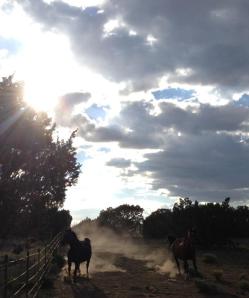 Start by doing this, if you’re interested: If you have a pasture or big space, go out there with your horse, feel the air, breathe in deeply. Feel the earth beneath your shoes, what does it feel like? Can you visualize your feet going deeper into the ground? Where is your horse while you’re doing this? Sometimes your horse will come in closer or want to stand near and breathe with you. Sometimes your horse will want your hand on her body. Follow the horse’s lead, as long as you feel safe. Generally when this is happening, you and your horse are quiet. Imagine yourself as just being one with the herd, with your horse.
Start by doing this, if you’re interested: If you have a pasture or big space, go out there with your horse, feel the air, breathe in deeply. Feel the earth beneath your shoes, what does it feel like? Can you visualize your feet going deeper into the ground? Where is your horse while you’re doing this? Sometimes your horse will come in closer or want to stand near and breathe with you. Sometimes your horse will want your hand on her body. Follow the horse’s lead, as long as you feel safe. Generally when this is happening, you and your horse are quiet. Imagine yourself as just being one with the herd, with your horse.
Horses who have lived wild for a long part of their lives, such as mustangs and many rescues, will have these Foundations very much intact and know that you are speaking their language when you slow down to zero for them. My own mare, Zuzka, is an amazing example of this. Although not a mustang, she grew up in a herd of 50 head of horses and had very limited contact with humans before I brought her home at age six. She had been saddle trained and then put back on pasture for two more years, before I got her. To catch her was quite challenging at that time. But once she was in a corral and I could approach her, my breath and the touch of my hand on her body served as the entry point to our lifelong friendship.
I might also add that all this amazingness of relationship doesn’t secure you a spot on the back of such a horse; lots of work had to be done with figuring out bucking and resistance, but that’s where everything takes time and listening, listening to the wind if necessary, if you aren’t getting anything really clear from your horse.
Zuzka has taught me about standing still with her, breathing with her, listening to the wind. She teaches me what all horses know but may not convey to people, that having highly tuned senses is of utmost value, thinking as a herd, and not thinking as a predator.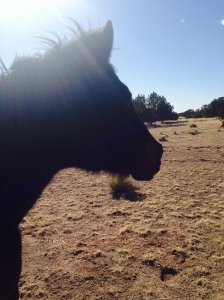
If you begin doing this with your horse and want somewhere to go with it, attend one of my clinics. We will take the journey into the heart of what the horse would love you to know, and how to set fair boundaries within their world. From here you will begin to see that the ways of force and pushing horses has no place in cooperative Liberty Foundations. From here you will be able to add other schooling but in a joyful community manner that will bring curiosity to your horse. With continued practice, watch unwanted behaviors fall away, even within herds.
I believe you will be glad you did.
****
(copyright: Susan Smith, OrthoHorse)
Services: Bodywork (Ortho-Bionomy for people, Equine Ortho-Bionomy): private sessions, tutorials, phone consultations, distance healing communication and gift certificates
Liberty Coaching: clinics, mini-clinics, workshops, private and semi-private sessions, tutorials, consultations: by appointment: 505.501.2478 or emailing susansmith@orthohorse.info Spring Lessons – semi-private, private and small group sessions. Scheduling now. Contact me for details.
If you want to host a clinic in your area, contact me to make arrangements. Prices will vary according to location and travel. susansmith@orthohorse.info 505-501-2478
I conducted a free Liberty Coaching Call on March 12. If you did not have a chance to listen, here is the link: http://www.susith.com/orthohorse/freehorseatlibcall.mp3
On the schedule for 2014:
May 3 Arrowhead Ranch, One-Day Liberty Horsemanship Clinic – 9 – 4:30 p.m. Contact Susan Smith for details.
June 14th – Trail Riding Clinic
Where: Headquarters Well, Caja Del Rio, Santa Fe
Time: 9 a.m.-noon
Limited to 4 riders.
Cost: $75
Do you have questions or difficulties riding on the trail with your horse? What would you like to know to make your ride more enjoyable?
Come learn from a seasoned endurance rider the following tips:
• Trail etiquette
• How to get your horse ready for a trail ride
• Where to go
• What to bring with you
• Equipment
• Training
When we ask a horse to listen to us when we’re on a trail with other horses, we’re asking her to engage with us instead of with the other horses and the distractions that can occur on the trail. In this way, trail riding exposes what is not working in the arena and it exposes where your relationship with your horse needs strengthening. Find out some similarities between liberty training and trail riding.
In this clinic we will talk first about preparation and then work on some ways to manage situations on the trail, while in the saddle. We will take a short trail ride.
Bring:
• Snacks
• Water for you and your horse
• Hay if you want it
• Helmet
• Tack (saddle & some sort of horse headgear required)
Attend both clinics and receive a $15 discount on enrollment. Benefit from learning Liberty Foundations to enhance your trail experience.
Sign up today as enrollment is limited. Flyer for Trail Clinic forthcoming. Contact me for enrollment & liability forms and Payment information. PayPal & checks accepted.
Combining cumulative knowledge from over 18 years of endurance riding, Liberty Horsemanship and Ortho-Bionomy bodywork practice, Susan Smith brings a unique perspective to getting a horse and rider ready for the trail – in mind, body and spirit.
Combine this clinic with the 1-Day Liberty Foundation Clinic held on May 3rd at Arrowhead Ranch in Santa Fe, and get a $15 discount on the package. Liberty Foundation work is destined to deepen your trail experience.
Contact Susan Smith@ susansmith@orthohorse.info or 505-501-2478.
*****
Check out this from Ruella Yates, my hostess and co-clinician at SHR in April – 10 Liberty Tips from Spirit Horse Ranch:
Ruella Yates, who is the marvel behind the HorseConscious Facebook page, has just released a brand new ebook called: “10 Liberty Tips From Spirit Horse Ranch” based upon her Liberty Foundations teachings.
What’s great about the book is that it’s packed full of really valuable advice yet very easy to consume and put into practice. I highly recommend you snag yourself a copy here:



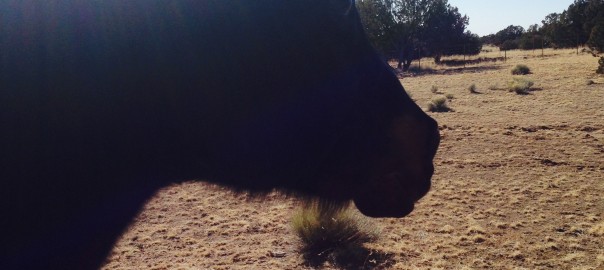
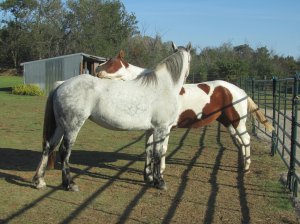
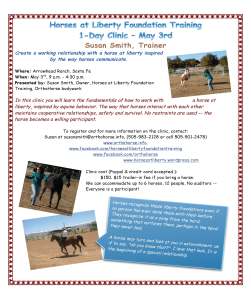
This is nearly poetry, Susan…The song of the herd is calling us to know them, to become one with them. We find that in our Liberty Foundations.
With joy,
Ruella Yates
Spirit Horse Ranch Liberty Foundations.
What a great blog!